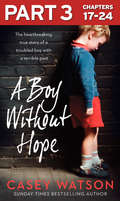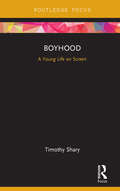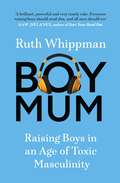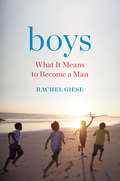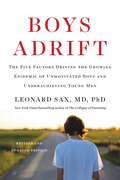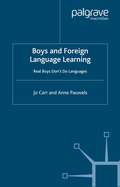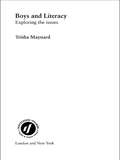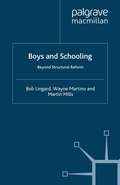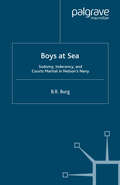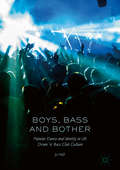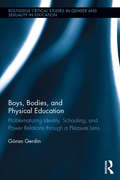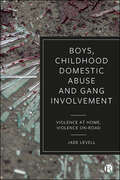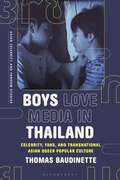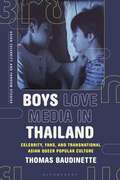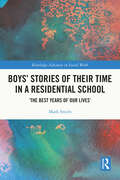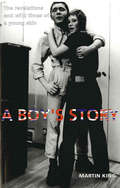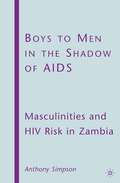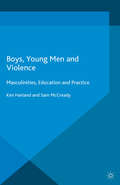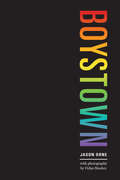- Table View
- List View
A Boy Without Hope: Part 3 of 3
by Casey WatsonA BOY WITHOUT HOPE is the heart-breaking story of a boy who didn’t know the meaning of love. A history of abuse and neglect has left Miller destined for life’s scrap heap. But in this turbulent story of conflict and struggle, Casey Watson is determined to help Miller overcome his demons, show him love and give him hope.
Boyhood: A Young Life on Screen (Cinema and Youth Cultures)
by Timothy SharyThis book traces the development of Richard Linklater’s Boyhood from its audacious concept through its tenacious production to its celebrated reception, placing it within the context of cinematic parables about children to demonstrate its distinctive vision. Timothy Shary, author of numerous studies on the history of teen cinema, evaluates the film’s many messages about youth and adolescence within the context of early twenty-first century American culture, illuminating how Linklater’s singular vision of the otherwise ordinary life of a boy reveals potent universal truths about all people.
Boyhood: A Young Life on Screen (Cinema and Youth Cultures)
by Timothy SharyThis book traces the development of Richard Linklater’s Boyhood from its audacious concept through its tenacious production to its celebrated reception, placing it within the context of cinematic parables about children to demonstrate its distinctive vision. Timothy Shary, author of numerous studies on the history of teen cinema, evaluates the film’s many messages about youth and adolescence within the context of early twenty-first century American culture, illuminating how Linklater’s singular vision of the otherwise ordinary life of a boy reveals potent universal truths about all people.
BoyMum
by Ruth Whippman'BoyMum is one of the most thought-provoking books I've read as a parent' The Times BoyMum is about boys and young men - how we are raising them, and what it means to be a man-in-the-making in an era when #MeToo has challenged our tolerance for toxic masculinity, yet the pressure on young men to be 'masculine' has never been more intense.It is also a mother's perspective. Ruth Whippman is the proud/overwhelmed, feminist mother of three boys and her family life can be a daily confrontation with the triumph of nature over nurture. All too aware that her parenting today will shape the men her sons become tomorrow, she explores the expectations placed on boys - must boys be boys?; the messages we send girls but not boys (but they really need to hear too); boys in the classroom and boys online; incels; entitlement, sexual harassment and "cancel culture" and what radicalizes young men.Blending memoir with cultural analysis, and approaching her subject with wit, honesty and open-mindedness, this is a sympathetic investigation into where we are going wrong with raising boys, and how trying to change those patterns must be one of society's most urgent cultural projects. Praise for Ruth Whippman and The Pursuit of Happiness - "A whip-sharp British Bill Bryson" The Sunday Times - "Ruth Whippman is whip-smart, her writing nothing short of genius" Huffington Post- The Pursuit of Happiness was a New York Post Best Book of 2016, a New York Times Editors' Choice and Paperback Row pick, one of Newsweek's 'Nine Books to Change the Way You Think in 2016', a Sunday Times top summer read and a Daily Mail 'Must Read'.- Ruth Whippman manages the trick of being funny about what is, deep down, a serious problem: the American quest for happiness isn't working" Oliver Burkeman, author of Four Thousand Weeks- "I LOVED this book. I found it SO WELL WRITTEN, so witty and funny and reading it I was often envious of Ruth Whippman's facility with language. It was a hugely engaging read, accessible and so relevant... I've been quite evangelical about it." Marian Keyes, best-selling author of Grown Ups
Boys: What It Means to Become a Man
by Rachel GieseA vital and sweeping examination of today's "boy crisis," demonstrating the ways in which we raise boys into a culture of toxic masculinity and offering solutions that can liberate us allWhether they're being urged to "man up" or warned that "boys don't cry," young men are subjected to damaging messages about manliness: they must muzzle their emotions and never show weakness, dominate girls and compete with one another.Boys: What It Means to Become a Man examines how these toxic rules can hinder boys' emotional and social development. If girls can expand the borders of femaleness, could boys also be set free of limiting, damaging expectations about manhood and masculinity? Could what's been labelled "the boy crisis" be the beginning of a revolution in how we raise young men? Drawing on extensive research and interviews with educators, activists, parents, psychologists, sociologists, and young men, Giese--mother to a son herself--examines the myths of masculinity and the challenges facing boys today. She reports from boys-only sex education classes and recreational sports leagues; talks to parents of transgender children and plays video games with her son. She tells stories of boys navigating the transition into manhood and how the upheaval in cultural norms about sex, sexuality and the myths of masculinity have changed the coming of age process for today's boys. With lively reportage and clear-eyed analysis, Giese reveals that the movement for gender equality has the potential to liberate us all.
Boys Adrift: The Five Factors Driving the Growing Epidemic of Unmotivated Boys and Underachieving Young Men
by Leonard SaxWhy America's sons are underachieving, and what we can do about it.Something is happening to boys today. From kindergarten to college, American boys are, on average, less resilient and less ambitious than they were a mere twenty years ago. The gender gap in college attendance and graduation rates has widened dramatically. While Emily is working hard at school and getting A's, her brother Justin is goofing off. He's more concerned about getting to the next level in his videogame than about finishing his homework.In Boys Adrift, Dr. Leonard Sax delves into the scientific literature and draws on more than twenty years of clinical experience to explain why boys and young men are failing in school and disengaged at home. He shows how social, cultural, and biological factors have created an environment that is literally toxic to boys. He also presents practical solutions, sharing strategies which educators have found effective in re-engaging these boys at school, as well as handy tips for parents about everything from homework, to videogames, to medication.
Boys and Foreign Language Learning: Real Boys Don't Do Languages
by J. Carr A. PauwelsThe authors examine the continuing poor relationship between boys and the study of foreign languages. Framed by discussion of gender socialization, gendered curriculum practices and cultural narratives about boys and schooling, the core of the book is constructed by boys themselves.
Boys and Literacy: Exploring the Issues (Language and Literacy in Action)
by Trisha MaynardIn recent years the issue of boys and literacy, namely that they are worse at it compared to girls, has become a key area of interest to all those concerned with the education of our children. This book highlights the key factors causing this divide and discusses the implementation of new strategies to overcome it, which have been the result of extensive qualitative research made by the author. Trisha Maynard reports case study findings of a primary school whose staff wanted to explore and improve boys' attitudes towards and attainment in literacy, and in particular their difficulties with writing.The book highlights issues concerning the reading and writing of stories, what teachers understand by 'good story writing' and the importance of teachers exploring boys' and girls' difficulties with literacy by themselves. It provides significant insight into boys' difficulties with writing as well as informing teachers how to find out about children's attainment.
Boys and Literacy: Exploring the Issues (Language and Literacy in Action)
by Trisha MaynardIn recent years the issue of boys and literacy, namely that they are worse at it compared to girls, has become a key area of interest to all those concerned with the education of our children. This book highlights the key factors causing this divide and discusses the implementation of new strategies to overcome it, which have been the result of extensive qualitative research made by the author. Trisha Maynard reports case study findings of a primary school whose staff wanted to explore and improve boys' attitudes towards and attainment in literacy, and in particular their difficulties with writing.The book highlights issues concerning the reading and writing of stories, what teachers understand by 'good story writing' and the importance of teachers exploring boys' and girls' difficulties with literacy by themselves. It provides significant insight into boys' difficulties with writing as well as informing teachers how to find out about children's attainment.
Boys and Schooling: Beyond Structural Reform
by B. Lingard W. Martino M. MillsExploring current approaches to addressing boys' education in schools, this book highlights the limitations of structural reform initiatives and the failure to address the impact of socioeconomic status, race, sexuality, disability and hegemonic masculinity on both boys' and girls' participation in schooling.
Boys at Sea: Sodomy, Indecency, and Courts Martial in Nelson's Navy
by B. BurgBoys at Sea is a study of homoerotic life in the Royal Navy during the age of sail. The book traces every feature of sexual life at sea, including seduction, rape, prostitution, courts martial, and the punishments meted out to those convicted of violating the stern moral code set down in the Articles of War .
Boys, Bass and Bother: Popular Dance and Identity in UK Drum ’n’ Bass Club Culture 1st ed
by Jo HallThis book uses ethnographic research to examine the role of dance in the construction of identity in the distinctly British electronic dance music club culture of drum ’n’ bass. Dancing is revealed as the central way in which drum ’n’ bass clubbers construct and perform their identities, which are informed, although not defined, by the club culture’s histories. The intertextual and intercultural development of drum ’n’ bass musical and clubbing culture is shown to be represented in the dancing body, prompting a challenge to the discourse of cultural appropriation. Popular representations of identities are embodied by drum ’n’ bass clubbers through affective transmission via the popular screen, and in this process are re-valued in their embodiment. Using a socially orientated understanding of intertextuality, the popular dancing body is shown to be heterocorporeal: containing traces of prior meaning and logic yet replete with new meaning and significance.
Boys' Bodies: Sport, Health and Physical Activity
by Murray DrummondThis is a book about boys’ bodies, masculinities, and the ways in which boys navigate their lives from early childhood through to the beginning of adolescence. Drummond focuses on sport, health and physical activity, and adds context to the history of male bodies, the social construction of masculinity and the role of sport as a potential rite of passage for young males. Using rich descriptive interview data with 33 boys from the ages of 5 to 13, collected over an 8- year period, Boys’ Bodies identifies important issues including the significance of muscularity and strength as signifiers of masculinity and the need for boys to be involved in “blood sports” as well as “beat girls” in sporting competitions. The meaning of health and the perception of boys’ changing bodies over time are central to the discussion. The book will appeal to researchers, teachers, practitioners, policy makers and parents.
Boys, Bodies, and Physical Education: Problematizing Identity, Schooling, and Power Relations through a Pleasure Lens (Routledge Critical Studies in Gender and Sexuality in Education)
by Göran GerdinUsing visual ethnography, this book explores the many forms of pleasures that boys derive in and through the spaces and their bodies in physical education. Employing the works of Michel Foucault and Judith Butler, Gerdin examines how pleasure is connected to identity, schooling, and power relations, and demonstrates how discourses of sport, fitness, health and masculinity work together to produce a variety of pleasurable experiences. At the same time, the book provides a critique of such pleasurable experiences within physical education by illustrating how these pleasures can still, for some boys, quickly turn into displeasures and can be associated with exclusion, humiliation, bullying and homophobia. Boys, Bodies, and Physical Education argues that pleasure can both be seen as an educational and productive practice in physical education but also a constraint that both engenders and privileges some boys over others as well as (re)producing narrow and limited conceptions of masculinity and pleasures for all boys. This book works to problematize these pleasures and their articulations with gender, bodies, and spaces.
Boys, Bodies, and Physical Education: Problematizing Identity, Schooling, and Power Relations through a Pleasure Lens (Routledge Critical Studies in Gender and Sexuality in Education)
by Göran GerdinUsing visual ethnography, this book explores the many forms of pleasures that boys derive in and through the spaces and their bodies in physical education. Employing the works of Michel Foucault and Judith Butler, Gerdin examines how pleasure is connected to identity, schooling, and power relations, and demonstrates how discourses of sport, fitness, health and masculinity work together to produce a variety of pleasurable experiences. At the same time, the book provides a critique of such pleasurable experiences within physical education by illustrating how these pleasures can still, for some boys, quickly turn into displeasures and can be associated with exclusion, humiliation, bullying and homophobia. Boys, Bodies, and Physical Education argues that pleasure can both be seen as an educational and productive practice in physical education but also a constraint that both engenders and privileges some boys over others as well as (re)producing narrow and limited conceptions of masculinity and pleasures for all boys. This book works to problematize these pleasures and their articulations with gender, bodies, and spaces.
Boys, Childhood Domestic Abuse, and Gang Involvement: Violence at Home, Violence On-Road
by Jade LevellBoys and young men have been previously overlooked in domestic violence and abuse policy and practice, particularly in the case of boys who are criminalized and labelled as gang-involved by the time they reach their teens. Jade Levell offers radical and important insights into how boys in this context navigate their journey to manhood with the constant presence of violence in their lives, in addition to poverty and racial marginalization. Of equal interest to academics and front-line practitioners, the book highlights the narratives of these young men and makes practice recommendations for supporting these ‘hidden victims’.
Boys, Childhood Domestic Abuse, and Gang Involvement: Violence at Home, Violence On-Road
by Jade LevellBoys and young men have been previously overlooked in domestic violence and abuse policy and practice, particularly in the case of boys who are criminalized and labelled as gang-involved by the time they reach their teens. Jade Levell offers radical and important insights into how boys in this context navigate their journey to manhood with the constant presence of violence in their lives, in addition to poverty and racial marginalization. Of equal interest to academics and front-line practitioners, the book highlights the narratives of these young men and makes practice recommendations for supporting these ‘hidden victims’.
Boys Love Media in Thailand: Celebrity, Fans, and Transnational Asian Queer Popular Culture (Asian Celebrity and Fandom Studies)
by Thomas BaudinetteOver the past several years, the Thai popular culture landscape has radically transformed due to the emergence of “Boys Love” (BL) soap operas which celebrate the love between handsome young men. Boys Love Media in Thailand: Celebrity, Fans, and Transnational Asian Queer Popular Culture is the first book length study of this increasingly significant transnational pop culture phenomenon. Drawing upon six years of ethnographic research, the book reveals BL's impacts on depictions of same-sex desire in Thai media culture and the resultant mainstreaming of queer romance through new forms of celebrity and participatory fandom. The author explores how the rise of BL has transformed contemporary Thai consumer culture, leading to heterosexual female fans of male celebrities who perform homoeroticism becoming the main audience to whom Thai pop culture is geared. Through the case study of BL, this book thus also investigates how Thai media is responding to broader regional trends across Asia where the economic potentials of female and queer fans are becoming increasingly important. Baudinette ultimately argues that the center of queer cultural production in Asia has shifted from Japan to Thailand, investigating both the growing international fandom of Thailand's BL series as well as the influence of international investment into the development of these media. The book particularly focuses on specific case studies of the fandom for Thai BL celebrity couples in Thailand, China, the Philippines, and Japan to explore how BL series have transformed each of these national contexts' queer consumer cultures.
Boys Love Media in Thailand: Celebrity, Fans, and Transnational Asian Queer Popular Culture (Asian Celebrity and Fandom Studies)
by Thomas BaudinetteOver the past several years, the Thai popular culture landscape has radically transformed due to the emergence of “Boys Love” (BL) soap operas which celebrate the love between handsome young men. Boys Love Media in Thailand: Celebrity, Fans, and Transnational Asian Queer Popular Culture is the first book length study of this increasingly significant transnational pop culture phenomenon. Drawing upon six years of ethnographic research, the book reveals BL's impacts on depictions of same-sex desire in Thai media culture and the resultant mainstreaming of queer romance through new forms of celebrity and participatory fandom. The author explores how the rise of BL has transformed contemporary Thai consumer culture, leading to heterosexual female fans of male celebrities who perform homoeroticism becoming the main audience to whom Thai pop culture is geared. Through the case study of BL, this book thus also investigates how Thai media is responding to broader regional trends across Asia where the economic potentials of female and queer fans are becoming increasingly important. Baudinette ultimately argues that the center of queer cultural production in Asia has shifted from Japan to Thailand, investigating both the growing international fandom of Thailand's BL series as well as the influence of international investment into the development of these media. The book particularly focuses on specific case studies of the fandom for Thai BL celebrity couples in Thailand, China, the Philippines, and Japan to explore how BL series have transformed each of these national contexts' queer consumer cultures.
Boys’ Stories of Their Time in a Residential School: ‘The Best Years of Our Lives’ (Routledge Advances in Social Work)
by Mark SmithThis book provides rich insights into the pre and post care experiences of boys who were pupils in a residential school where the author worked over the course of the 1980s. It describes the boys’ trajectories through life, as well as detailing the rhythms, rituals, routines, and relationships that existed in the school. While the focus is on the (former) boys’ experiences, these are augmented by interview material from staff members, including religious Brothers, who worked in the school. Together, these different perspectives provide unique insights into an area of social work history that is ill-served by existing accounts, making the book required reading for all scholars and students of social work; social and oral history; narrative sociology; criminology and desistance and social policy.
Boys’ Stories of Their Time in a Residential School: ‘The Best Years of Our Lives’ (Routledge Advances in Social Work)
by Mark SmithThis book provides rich insights into the pre and post care experiences of boys who were pupils in a residential school where the author worked over the course of the 1980s. It describes the boys’ trajectories through life, as well as detailing the rhythms, rituals, routines, and relationships that existed in the school. While the focus is on the (former) boys’ experiences, these are augmented by interview material from staff members, including religious Brothers, who worked in the school. Together, these different perspectives provide unique insights into an area of social work history that is ill-served by existing accounts, making the book required reading for all scholars and students of social work; social and oral history; narrative sociology; criminology and desistance and social policy.
A Boy's Story: The Revelations and Wild Times of a Young Skin
by Martin KingAs the 1960's drew to a close, parents across Britain raised a curious eyebrow as their long-haired children suddenly returned home with shaven heads, sporting Levi's jeans and vicious looking army boots, pleading for three quid to buy a Harrington jacket from the market. The skinhead was born and a youth culture stronger and more widespread than any other, before or since, took Britain by storm. Marting King was one of them. Boys and girls alike embraced this new working-class fashion and music - the West Indian reggae sounds of Blue Beat and the strong sense of identity they fostered. For a couple of summers the media would have it that England was under seige, when the young skins paraded at seaside resorts on bank holidays and later on terraces at nearly every football ground acros the country. With his passion for Chelsea FC and their growing reputation as the skinhead club forming a backdrop, King artfully and humorously describes the heady mix of pleasures which were all part of life as a teenager growing up in working-class south London in the late 60's
Boys to Men in the Shadow of AIDS: Masculinities and HIV Risk in Zambia
by A. SimpsonThis ethnography charts the lives of mission-educated men in Zambia and their search for meaning in the AIDS pandemic, as well as their responses to prevention and HIV testing. It also suggests how hegemonic masculinities may begin to be re-figured and gender relationships redesigned.
Boys, Young Men and Violence: Masculinities, Education and Practice
by Ken Harland Sam McCreadyThis book draws upon data collected over an 18 year period with over 1000 boys and young men across Northern Ireland. Providing critical reflections on violence, masculinity and education, it uses the voices and experiences of young men to inform and influence research, practice and policy.
Boystown: Sex and Community in Chicago
by Jason OrneFrom neighborhoods as large as Chelsea or the Castro, to locales limited to a single club, like The Shamrock in Madison or Sidewinders in Albuquerque, gay areas are becoming normal. Straight people flood in. Gay people flee out. Scholars call this transformation assimilation, and some argue that we—gay and straight alike—are becoming “post-gay.” Jason Orne argues that rather than post-gay, America is becoming “post-queer,” losing the radical lessons of sex. In Boystown, Orne takes readers on a detailed, lively journey through Chicago’s Boystown, which serves as a model for gayborhoods around the country. The neighborhood, he argues, has become an entertainment district—a gay Disneyland—where people get lost in the magic of the night and where straight white women can “go on safari.” In their original form, though, gayborhoods like this one don’t celebrate differences; they create them. By fostering a space outside the mainstream, gay spaces allow people to develop an alternative culture—a queer culture that celebrates sex. Orne spent three years doing fieldwork in Boystown, searching for ways to ask new questions about the connective power of sex and about what it means to be not just gay, but queer. The result is the striking Boystown, illustrated throughout with street photography by Dylan Stuckey. In the dark backrooms of raunchy clubs where bachelorettes wouldn’t dare tread, people are hooking up and forging “naked intimacy.” Orne is your tour guide to the real Boystown, then, where sex functions as a vital center and an antidote to assimilation.
